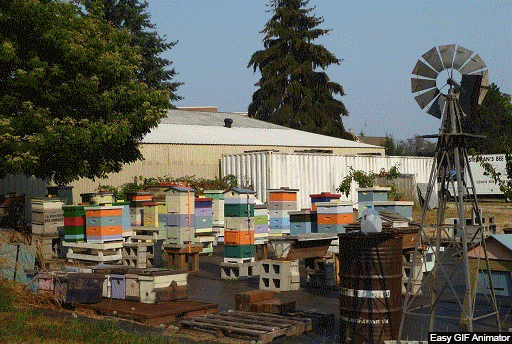Langstroth Hives


The Langstroth is the most common form of hive both commercially and with hobbyist. The majority of beekeepers start with the Langstroth in either the 8 or 10 frame style.
The advantage is it is easy to use readably available and it components are interchangeable.
The disadvantage is that the boxes especially the 10 frame boxes get very heavy when full of honey (+70 lbs)


Langstroth hives
The key innovation of this type of hive was the use of vertically hanging frames on which bees build their comb.
The modern Langstroth hive consists of:
-
Bottom board: this has an entrance for the bees
-
Boxes containing frames for brood and honey: the lowest box for the queen to lay eggs, and boxes above where honey is stored.
-
Inner cover and top cap providing weather protection.
Named for their inventor, Rev. Lorenzo Langstroth, Langstroth hives are probably the most commonly used. Langstroth patented his design in 1852 originally for comb honey production; it has become the standard style hive for many of the world's beekeepers.
This class of hives includes other styles, which differ mainly in the size and number of frames used. These include Smith, British National, Segeberger Beute (German), D.E. hive, Frankenbeute (German), Normalmass (German), and Dadant hive (developed in USA in 1920 from the Dadant-Blatt hive, plus regional variations.
A common feature of Langstroth hives is the use of specific bee spaces between frames and other parts so that bees are not likely to glue together nor fill these spaces with burr comb: comb joining adjacent frames. The sizes of hive bodies (rectangular boxes without tops or bottoms placed one on top of another) and internal frames are relatively well defined for a particular style. Langstroth hive bodies are rectangular in shape and can be made from a variety of materials that can be stacked to expand the usable space for the bees. Inside the boxes, frames are hung parallel to each other.
Langstroth frames are thin rectangular structures made of wood or plastic and typically have a wax or plastic foundation on which the bees draw out the comb. The frames hold the beeswax honeycomb formed by the bees. Ten frames side by side will fill the hive body and leave the right amount of bee space between each frame and between the end frames and the hive body.
Langstroth frames are often reinforced with wire, making it possible to spin the honey out of the comb in a centrifuge. As a result, the empty frames and comb can be returned to the beehive for re-filling by the bees. Creating honeycomb involves a significant energy investment, conservatively estimated at 6.25 kilograms of honey needed to create 1 kilogram of comb in temperate climates. Reusing comb can thus increase the productivity of a beekeeping enterprise.
Source Wikipedia


